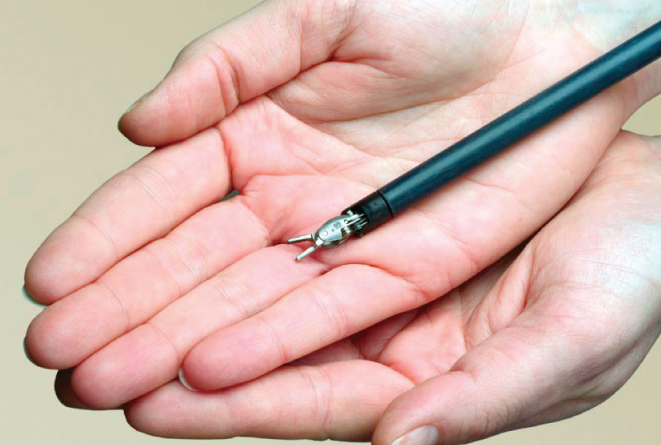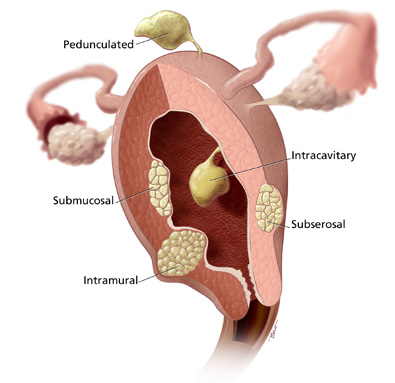The Conditions
A uterine fibroid is a benign (non-cancerous) tumor that can grow inside and outside the uterus. Uterine fibroids are most common in women ages 30 to 40, but can occur at any age.An estimated 20 to 80% of women develop fibroids by age 50.Uterine fibroids are the most common reason a hysterectomy is performed.Uterine fibroids can grow as a single tumor or in clusters. They may increase in size and frequency with age, but may shrink after menopause. Not all women experience symptoms due to fibroids. When symptoms are present, they can include heavy menstrual bleeding, pelvic pain, frequent urination and difficulty getting pregnant
A uterine fibroid is a benign (non-cancerous) tumor that can grow inside and outside the uterus. Uterine fibroids are most common in women ages 30 to 40, but can occur at any age.An estimated 20 to 80% of women develop fibroids by age 50.Uterine fibroids are the most common reason a hysterectomy is performed.Uterine fibroids can grow as a single tumor or in clusters. They may increase in size and frequency with age, but may shrink after menopause. Not all women experience symptoms due to fibroids. When symptoms are present, they can include heavy menstrual bleeding, pelvic pain, frequent urination and difficulty getting pregnant.
The Surgery. Myomectomy
When medication, lifestyle changes and other non- invasive treatments do not ease your symptoms, your doctor may recommend surgery. Myomectomy is an alternative to hysterectomy for treating fibroids. During myomectomy, your surgeon removes the fibroid tumor(s) while leaving your uterus in place. Myomectomy is recommended for women who want to become pregnant or keep their uterus for other reasons.
Myomectomy can be performed using traditional open surgery, meaning a large incision is made in the lower abdomen. The incision must be large enough for your surgeon to fit his or her hands and surgical instruments inside your body and reach your uterus. Open surgery allows your surgeon to see and touch your organs.
Laparoscopic surgery is a minimally invasive alternative to open surgery. With laparoscopy, doctors operate through a few small incisions with long-handled instruments and a tiny camera. The camera sends images to a monitor which guides doctors as they operate. Another minimally invasive surgical option for women considering myomectomy is da Vinci Surgery.

da Vinci Surgery: A Minimally Invasive Surgical Option
If your doctor recommends surgery, ask about da VinciMyomectomy. With da Vinci, surgeons operate through a few small incisions – similar to traditional laparoscopy. The da Vinci System features a magnified 3D HD vision system and wristed instruments that rotate far greater than the human wrist. These features enable surgeons to operate with enhanced vision, precision, dexterity and control.
As a result of da Vinci technology, da Vinci Myomectomy offers the following potential benefits over open surgery:
• Less blood loss
• Shorter hospital stay
• Less narcotic pain medicine required
• Small incisions for minimal scarring
• Small incision for virtually scarless results
As a result of da Vinci technology, da Vinci Myomectomy offers the following potential benefits compared to traditional laparoscopy:
• Greater likelihood your surgeon can remove heavier fibroids
• Fewer complications during surgery
Patient Testimonials
The Enabling Technology: da Vinci Surgical System
The da Vinci Surgical System is designed to provide surgeons with enhanced capabilities, including high- definition 3D vision and a magnified view. Your doctor controls the da Vinci System, which translates his or her hand movements into smaller, more precise movements of tiny instruments inside your body.
Though it is often called a “robot,” da Vinci cannot act on its own. Surgery is performed entirely by your doctor. Together, da Vinci technology allows your doctor to perform routine and complex procedures through just a few small openings, similar to traditional laparoscopy.
The da Vinci System has been used successfully worldwide in approximately 1.5 million various surgical procedures to date. da Vinci – changing the experience of surgery for people around the world.

Content provided by Intuitive Surgical.



